现代语言学 简答整理
【简答题】语言学纲要
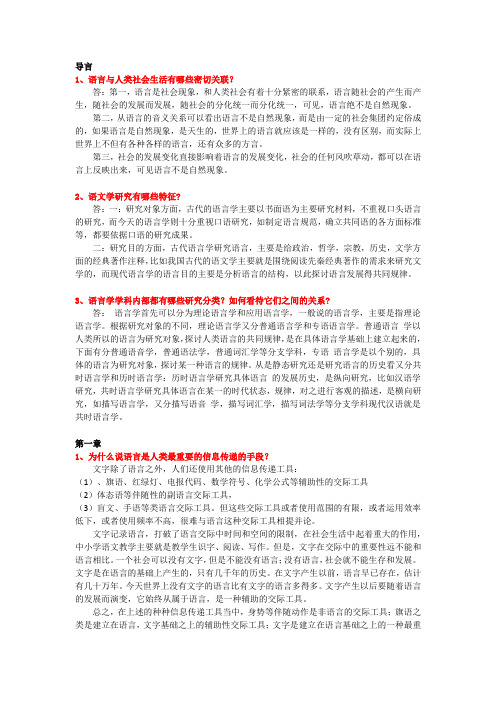
导言1、语言与人类社会生活有哪些密切关联?答:第一,语言是社会现象,和人类社会有着十分紧密的联系,语言随社会的产生而产生,随社会的发展而发展,随社会的分化统一而分化统一,可见,语言绝不是自然现象。
第二,从语言的音义关系可以看出语言不是自然现象,而是由一定的社会集团约定俗成的,如果语言是自然现象,是天生的,世界上的语言就应该是一样的,没有区别,而实际上世界上不但有各种各样的语言,还有众多的方言。
第三,社会的发展变化直接影响着语言的发展变化,社会的任何风吹草动,都可以在语言上反映出来,可见语言不是自然现象。
2、语文学研究有哪些特征?答:一:研究对象方面,古代的语言学主要以书面语为主要研究材料,不重视口头语言的研究,而今天的语言学则十分重视口语研究,如制定语言规范,确立共同语的各方面标准等,都要依据口语的研究成果。
二:研究目的方面,古代语言学研究语言,主要是给政治,哲学,宗教,历史,文学方面的经典著作注释,比如我国古代的语文学主要就是围绕阅读先秦经典著作的需求来研究文学的,而现代语言学的语言目的主要是分析语言的结构,以此探讨语言发展得共同规律。
3、语言学学科内部都有哪些研究分类?如何看待它们之间的关系?答:语言学首先可以分为理论语言学和应用语言学,一般说的语言学,主要是指理论语言学。
根据研究对象的不同,理论语言学又分普通语言学和专语语言学。
普通语言学以人类所以的语言为研究对象,探讨人类语言的共同规律,是在具体语言学基础上建立起来的,下面有分普通语音学,普通语法学,普通词汇学等分支学科,专语语言学是以个别的,具体的语言为研究对象,探讨某一种语言的规律。
从是静态研究还是研究语言的历史看又分共时语言学和历时语言学:历时语言学研究具体语言的发展历史,是纵向研究,比如汉语学研究,共时语言学研究具体语言在某一的时代状态,规律,对之进行客观的描述,是横向研究,如描写语言学,又分描写语音学,描写词汇学,描写词法学等分支学科现代汉语就是共时语言学。
自己整理的简答(语言学概论)
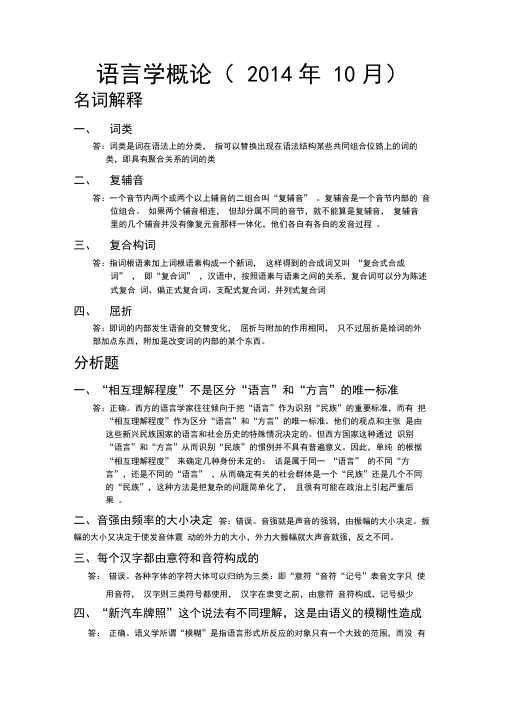
语言学概论(2014年10月)名词解释一、词类答:词类是词在语法上的分类,指可以替换出现在语法结构某些共同组合位臵上的词的类,即具有聚合关系的词的类二、复辅音答:一个音节内两个或两个以上辅音的二组合叫“复辅音” 。
复辅音是一个音节内部的音位组合。
如果两个辅音相连,但却分属不同的音节,就不能算是复辅音,复辅音里的几个辅音并没有像复元音那样一体化,他们各自有各自的发音过程。
三、复合构词答:指词根语素加上词根语素构成一个新词,这样得到的合成词又叫“复合式合成词” ,即“复合词” ,汉语中,按照语素与语素之间的关系,复合词可以分为陈述式复合词、偏正式复合词、支配式复合词、并列式复合词四、屈折答:即词的内部发生语音的交替变化,屈折与附加的作用相同,只不过屈折是给词的外部加点东西,附加是改变词的内部的某个东西。
分析题一、“相互理解程度”不是区分“语言”和“方言”的唯一标准答:正确。
西方的语言学家往往倾向于把“语言”作为识别“民族”的重要标准,而有把“相互理解程度”作为区分“语言”和“方言”的唯一标准。
他们的观点和主张是由这些新兴民族国家的语言和社会历史的特殊情况决定的。
但西方国家这种通过识别“语言”和“方言”从而识别“民族”的惯例并不具有普遍意义。
因此,单纯的根据“相互理解程度” 来确定几种身份未定的:话是属于同一“语言” 的不同“方言”,还是不同的“语言” ,从而确定有关的社会群体是一个“民族”还是几个不同的“民族”,这种方法是把复杂的问题简单化了,且很有可能在政治上引起严重后果。
二、音强由频率的大小决定答:错误。
音强就是声音的强弱,由振幅的大小决定。
振幅的大小又决定于使发音体震动的外力的大小,外力大振幅就大声音就强,反之不同。
三、每个汉字都由意符和音符构成的答:错误。
各种字体的字符大体可以归纳为三类:即“意符“音符“记号”表音文字只使用音符,汉字则三类符号都使用,汉字在隶变之前,由意符音符构成,记号极少四、“新汽车牌照”这个说法有不同理解,这是由语义的模糊性造成答:正确。
语言学知识点总结
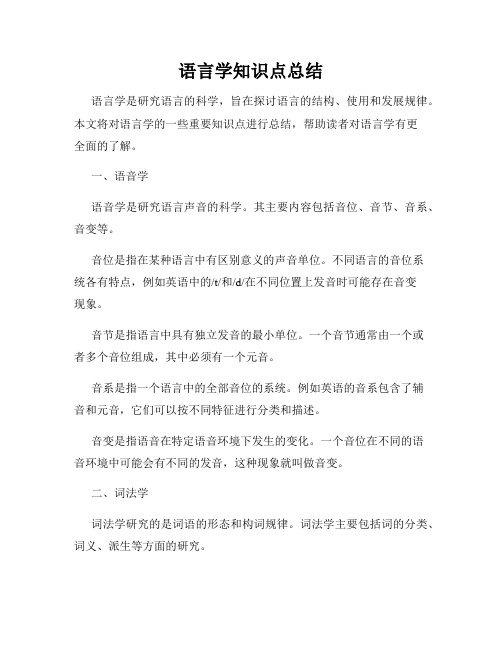
语言学知识点总结语言学是研究语言的科学,旨在探讨语言的结构、使用和发展规律。
本文将对语言学的一些重要知识点进行总结,帮助读者对语言学有更全面的了解。
一、语音学语音学是研究语言声音的科学。
其主要内容包括音位、音节、音系、音变等。
音位是指在某种语言中有区别意义的声音单位。
不同语言的音位系统各有特点,例如英语中的/t/和/d/在不同位置上发音时可能存在音变现象。
音节是指语言中具有独立发音的最小单位。
一个音节通常由一个或者多个音位组成,其中必须有一个元音。
音系是指一个语言中的全部音位的系统。
例如英语的音系包含了辅音和元音,它们可以按不同特征进行分类和描述。
音变是指语音在特定语音环境下发生的变化。
一个音位在不同的语音环境中可能会有不同的发音,这种现象就叫做音变。
二、词法学词法学研究的是词语的形态和构词规律。
词法学主要包括词的分类、词义、派生等方面的研究。
词的分类根据不同的分类标准,词可以分为名词、动词、形容词、副词等等。
不同类别的词在语法和词义上有各自的特点。
词义是指词的意义。
一个词可以有多个意义,根据上下文来理解具体的意思。
语境对于词义的理解非常重要。
派生是指通过添加前缀、后缀或者改变词形来创造新词。
派生是词语演化和发展的重要手段。
三、句法学句法学是研究句子结构和语法规则的学科。
它关注的是句子中词语的组织和句子之间的关系。
短语结构是指词语在句子中的组织形式。
一个句子可以被分解为若干个短语,它们按照一定的顺序组成句子的结构。
句法关系是指不同短语在句子中的语法关系。
例如主谓关系、动宾关系等。
句法关系对句子的理解和翻译都非常重要。
四、语义学语义学研究的是词语和句子的意义。
它试图解释语言中的概念和关系,了解句子的真实含义。
词义是词语的基本意思,通过词的定义、例句和上下文来解释词的意思。
句义是指句子的意义。
句意可以通过句子的结构和上下文来理解。
语用学研究的是语言使用的具体情境和交际功能。
它关注语言如何在特定环境中进行交流。
现代语言学 复习要点
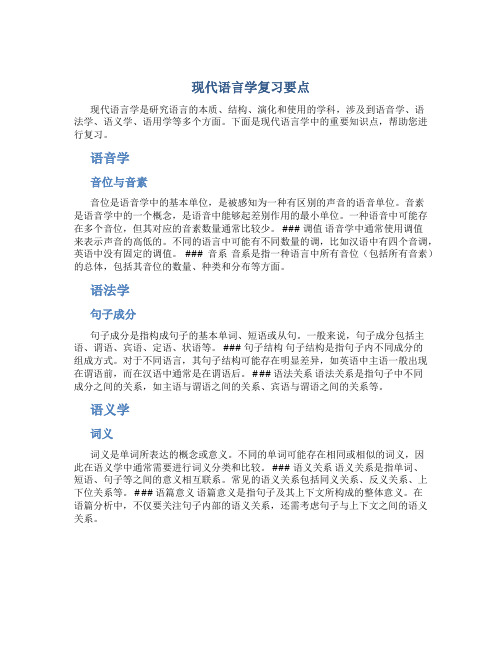
现代语言学复习要点现代语言学是研究语言的本质、结构、演化和使用的学科,涉及到语音学、语法学、语义学、语用学等多个方面。
下面是现代语言学中的重要知识点,帮助您进行复习。
语音学音位与音素音位是语音学中的基本单位,是被感知为一种有区别的声音的语音单位。
音素是语音学中的一个概念,是语音中能够起差别作用的最小单位。
一种语音中可能存在多个音位,但其对应的音素数量通常比较少。
### 调值语音学中通常使用调值来表示声音的高低的。
不同的语言中可能有不同数量的调,比如汉语中有四个音调,英语中没有固定的调值。
### 音系音系是指一种语言中所有音位(包括所有音素)的总体,包括其音位的数量、种类和分布等方面。
语法学句子成分句子成分是指构成句子的基本单词、短语或从句。
一般来说,句子成分包括主语、谓语、宾语、定语、状语等。
### 句子结构句子结构是指句子内不同成分的组成方式。
对于不同语言,其句子结构可能存在明显差异,如英语中主语一般出现在谓语前,而在汉语中通常是在谓语后。
### 语法关系语法关系是指句子中不同成分之间的关系,如主语与谓语之间的关系、宾语与谓语之间的关系等。
语义学词义词义是单词所表达的概念或意义。
不同的单词可能存在相同或相似的词义,因此在语义学中通常需要进行词义分类和比较。
### 语义关系语义关系是指单词、短语、句子等之间的意义相互联系。
常见的语义关系包括同义关系、反义关系、上下位关系等。
### 语篇意义语篇意义是指句子及其上下文所构成的整体意义。
在语篇分析中,不仅要关注句子内部的语义关系,还需考虑句子与上下文之间的语义关系。
语用学言语行为言语行为是指言语交流过程中所体现的具体行为,如陈述、命令、请求、批评等。
不同类型的言语行为具有不同的功能和表达方式。
### 语用礼貌语用礼貌是指在言语交际过程中对他人尊重、友好的表达方式。
常见的语用礼貌策略包括委婉语、礼貌用语、双重否定等。
### 上下文依存言语交际过程中,具体表达的含义通常需要依赖于上下文信息。
语言学概论单选、多选、名词解释、简答、论述、分析
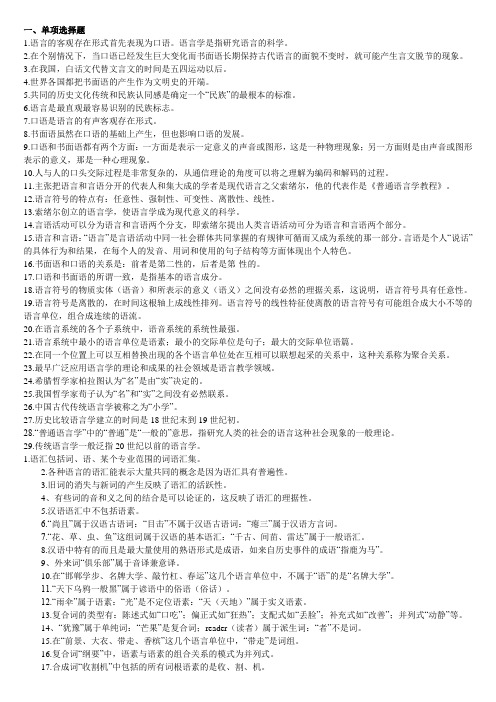
一、单项选择题1.语言的客观存在形式首先表现为口语。
语言学是指研究语言的科学。
2.在个别情况下,当口语已经发生巨大变化而书面语长期保持古代语言的面貌不变时,就可能产生言文脱节的现象。
3.在我国,白话文代替文言文的时间是五四运动以后。
4.世界各国都把书面语的产生作为文明史的开端。
5.共同的历史文化传统和民族认同感是确定一个“民族”的最根本的标准。
6.语言是最直观最容易识别的民族标志。
7.口语是语言的有声客观存在形式。
8.书面语虽然在口语的基础上产生,但也影响口语的发展。
9.口语和书面语都有两个方面:一方面是表示一定意义的声音或图形,这是一种物理现象;另一方面则是由声音或图形表示的意义,那是一种心理现象。
10.人与人的口头交际过程是非常复杂的,从通信理论的角度可以将之理解为编码和解码的过程。
11.主张把语言和言语分开的代表人和集大成的学者是现代语言之父索绪尔,他的代表作是《普通语言学教程》。
12.语言符号的特点有:任意性、强制性、可变性、离散性、线性。
13.索绪尔创立的语言学,使语言学成为现代意义的科学。
14.言语活动可以分为语言和言语两个分支,即索绪尔提出人类言语活动可分为语言和言语两个部分。
15.语言和言语:“语言”是言语活动中同一社会群体共同掌握的有规律可循而又成为系统的那一部分。
言语是个人“说话”的具体行为和结果,在每个人的发音、用词和使用的句子结构等方面体现出个人特色。
16.书面语和口语的关系是:前者是第二性的,后者是第-性的。
17.口语和书面语的所谓一致,是指基本的语言成分。
18.语言符号的物质实体(语音)和所表示的意义(语义)之间没有必然的理据关系,这说明,语言符号具有任意性。
19.语言符号是离散的,在时间这根轴上成线性排列。
语言符号的线性特征使离散的语言符号有可能组合成大小不等的语言单位,组合成连续的语流。
20.在语言系统的各个子系统中,语音系统的系统性最强。
21.语言系统中最小的语言单位是语素;最小的交际单位是句子;最大的交际单位语篇。
语言学概论简答题整理
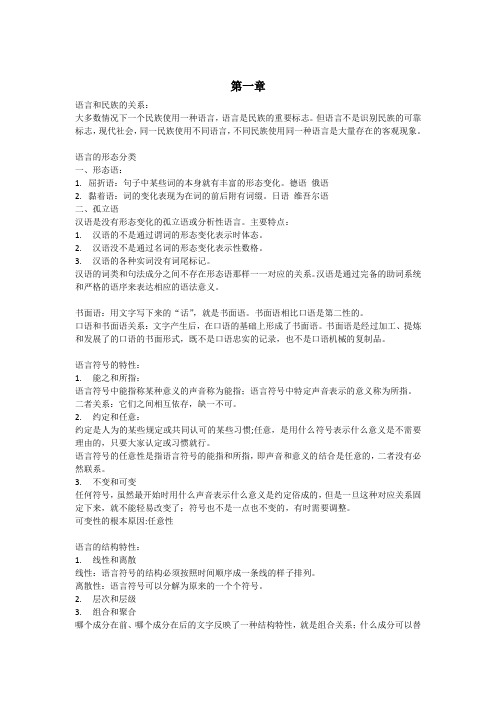
第一章语言和民族的关系:大多数情况下一个民族使用一种语言,语言是民族的重要标志。
但语言不是识别民族的可靠标志,现代社会,同一民族使用不同语言,不同民族使用同一种语言是大量存在的客观现象。
语言的形态分类一、形态语:1.屈折语:句子中某些词的本身就有丰富的形态变化。
德语俄语2.黏着语:词的变化表现为在词的前后附有词缀。
日语维吾尔语二、孤立语汉语是没有形态变化的孤立语或分析性语言。
主要特点:1.汉语的不是通过谓词的形态变化表示时体态。
2.汉语没不是通过名词的形态变化表示性数格。
3.汉语的各种实词没有词尾标记。
汉语的词类和句法成分之间不存在形态语那样一一对应的关系。
汉语是通过完备的助词系统和严格的语序来表达相应的语法意义。
书面语:用文字写下来的“话”,就是书面语。
书面语相比口语是第二性的。
口语和书面语关系:文字产生后,在口语的基础上形成了书面语。
书面语是经过加工、提炼和发展了的口语的书面形式,既不是口语忠实的记录,也不是口语机械的复制品。
语言符号的特性:1.能之和所指:语言符号中能指称某种意义的声音称为能指;语言符号中特定声音表示的意义称为所指。
二者关系:它们之间相互依存,缺一不可。
2.约定和任意:约定是人为的某些规定或共同认可的某些习惯;任意,是用什么符号表示什么意义是不需要理由的,只要大家认定或习惯就行。
语言符号的任意性是指语言符号的能指和所指,即声音和意义的结合是任意的,二者没有必然联系。
3.不变和可变任何符号,虽然最开始时用什么声音表示什么意义是约定俗成的,但是一旦这种对应关系固定下来,就不能轻易改变了;符号也不是一点也不变的,有时需要调整。
可变性的根本原因:任意性语言的结构特性:1.线性和离散线性:语言符号的结构必须按照时间顺序成一条线的样子排列。
离散性:语言符号可以分解为原来的一个个符号。
2.层次和层级3.组合和聚合哪个成分在前、哪个成分在后的文字反映了一种结构特性,就是组合关系;什么成分可以替换出现在某个位置上的问题反映了一种结构特性,是聚合关系。
00830现代语言学复习资料
现代语言学复习资料教材购买:第一章绪论?. , .. (普通语言学), , . (语音学). (音系学). (形态学). (句法学). (语义学). (语用学). (社会语言学). (心理语言学)( ) . (应用语言学), , ., (人类语言学) , (神经语言学) , (数字语言学) . (计算机语言学), , , ..., “” .; . , .., .:. ;. ;. , , .[ə'ə]. ., .. , .语言能力和语言运用. ’.’ , . .?“”“”“” ., , ., ...)., . ., . , . .), .), , , . , , . . ), , . . , .), , .**********************************音系学., . . “” ., .(语言的声音媒介) .(语音).. ?;’ .(发音语音学), ’ . .(听觉语音学),’ . .(声学语音学), . ..咽腔口腔鼻腔语音解剖图发音器官图. (字母符号) , (宽式音标). (变音符号), (窄式音标). 音的比较[]是不送气音,在宽式音标中不作标示,写作:[]音的比较在元音前,叫清晰音,在宽式音标中不作标示,写作:[][][][],在窄式音标中加变音符号[])塞音或爆破音: [] [] [] [] [] []擦音:[] [] [] [] [] [] [] [] []塞擦音:[][][] [][] [] [][] [])[] [] [] [][] [][] [][] [] [] [] [] [] [][][][][][] [] [][])前元音:[:] [] [] [] []中元音:[[:] [[] []后元音:[:] [] [:] [] [:])分:闭元音:[:] [] [:] []半闭元音:[] [[:]开元音:[] []半开元音:[[] [:] [] [] [:])圆唇元音:[:] [] [:] [])长元音[:] [[:][:] [:] [:]短元音[] [] [] [] [[] [] [] []音系学., ;, . ., ,. . .义。
现代语言学总结
所谓替代就是在相同的环境里,某个单位能 够用别的单位替换。直接成分就是把句子 或词按层次切分成其组成部分);对许多 语言的调查和描写提供了宝贵的语言学资 料。结构主义理论还广泛应用于当时的语 言教学,在该理论指导下产生的“听说教 学法”明显优于传统教学法,取得较好效 果。但结构主义分析法注重形式描写而不 重视语言能力的解释,缺乏对语言本质的 理论解释,忽视语言的普遍性,忽视意义 等等。 结构语言学的另一重要成果是音位学理论。
韩礼德认为,语言为什么演变成目前的形式 ,并没有什么先验的道理。语言之所以具有 现在的结构,是因为它必须完成特定的社会 功能。在任何社会中,不论其地理环境和物 质环境条件如何,语言都要完成一定的社会 功能。通过研究语言的功能,可以更好地认 识语言的结构。他认为,语言有三种功能: 概念功能,交际功能,语篇功能。 功能结构主义语言学(弗斯和韩礼德)功能 观点,后来为社会语言学所发展,从功能出 发,说明在特定言语环境中使用语言所达到 的特定交际目的。
一套行之有效的系统,严密而简明的分析系 统。另一理论上的突破在于将句法过程区 分出“生成与转换”两个阶段,并赋予这 两个阶段以不同的作用,这种明确的阶段 性区分使句法研究真正变成了可明确操作 的科学。 在方法论上,不同于之前的结构主义语法从 事实中发现规律的归纳法,生成语法学以 演绎法作为基本的推导方式,以验证假设 的形式探求语言最本质的内核。
1. “语言环境” 英国研究者一直强调语言环境的重要性。
最初,语言环境泛指整个文化背景和参加者的 背景。弗斯认为,意义不仅与环境犬牙交错 ,而且渗透到每个人的社会生活之中。所以 语言的意义离不开“语言环境”。要想理解 话语,归根结底要懂得说话人的整个文化背 景及其生活方式。环境变了,讲话人的角色 也随之变化,于是出现不同的语言变体。
00830现代语言学复习资料
现代语言学复习资料教材购买:第一章绪论?. , .. (普通语言学), , . (语音学). (音系学). (形态学). (句法学). (语义学). (语用学). (社会语言学). (心理语言学)( ) . (应用语言学), , ., (人类语言学) , (神经语言学) , (数字语言学) . (计算机语言学), , , ..., “” .; . , ., .:. ;. ;. , , .[ə'ə]. ., .. , .语言能力和语言运用. ’.’ , . .?.“”“”“” ., , ., .甄别性特征..)., . ., . , . .), .), , , . , , . . ), , . . , .), , .**********************************音系学., . . “” ., .(语言的声音媒介) .(语音).. ?;’ .(发音语音学), ’ . .(听觉语音学),’ . .(声学语音学), . ..咽腔口腔鼻腔语音解剖图发音器官图–. (字母符号) , (宽式音标). (变音符号), (窄式音标). 音的比较[][]音的比较在元音前,叫清晰音,在宽式音标中不作标示,写作:[][][][],在窄式音标中加变音符号[])发音方式分塞音或爆破音: [] [] [] [] [] []擦音:[] [] [] [] [] [] [] [] []塞擦音:[][][] [][] [] [][] [])[] [] [] [][] [][] [][] [] [] [] [] [] [][][][][][] [] [][])前元音:[:] [] [] [] []中元音:[[:] [[] []后元音:[:] [] [:] [] [:])闭元音:[:] [] [:] []半闭元音:[] [[:]开元音:[] []半开元音:[[] [:] [] [] [:])不圆唇元音:[:] [] [] [] [] [[:] [[] [] [:] 圆唇元音:[:] [] [:] [])长元音[:] [[:][:] [:] [:]短元音[] [] [] [] [[] [] [] []音系学., ;, . ., ,. . .定能区分意义。
语言学简答题问答题答案
《语言学概论》名词解释历史语言学:主要用历史的方法研究某种语言的短期的和长期的变化规律,如汉语史、英语史。
共时语言学:研究语言在某一时期的相对静止的情况,如现代汉语。
普通语言学:研究对象是人类语言,着重从理论上探讨语言的共同特点和一般规律,也叫一般语言学。
隐性意义:指隐藏在显性意义后面的各种语法关系,通常表现为施事与动作,动作与受事的关系等。
隐性形式:从微观角度看,句法结构的外部形式具有层次性。
这种层次性不能从外表一眼看出来,需要我们从小到大或从大到小地分析。
显性形式:从宏观上看,句法结构外部形式是线条性,我们把它叫显性形式。
语言学:是研究语言的科学。
语言学家研究的只是经过语言学家主观概括和不同程度上理想化和简单化了的语言。
符号:指的是根据社会的约定俗成使用某种特定的物质实体来表示某种特定的意义而形成的这种实体和意义的结合体。
“符号”必然包括有任何情况下永远不可分割的两个方面,一个方面是物质的实体,另一个方面是约定俗成的意义。
“能指”:是索绪尔给语言符号的物质实体创制的一个专门的术语。
也就是能够指称某种意义的成分。
“所指”:是索绪尔给符号所指的意义容创制的一个专门术语,也就是“能指成分”,即特定的物质实体,所指的意义容。
语音:虽是一种声音,但又与一般的声音有着本质的区别。
它是由人的发音器官发出的,负载着一定的意义,并作为语言符号系统载体的声音。
音素:是从音质角度划分出来的最小语音单位。
根据音质的不同,对一串语音不断加以切分,直到不能切分为止,这样得到的语音就是“音素”。
标写语音的书面符号叫做“音标”。
“音位”:就是从社会功能的角度划分出来的语音单位,它是特定语言或方言中具有区别意义作用的最小的语音单位。
“音质音位”和“非音质音位”:音位从构成材料上看,可以分为音质音位和非音质音位。
以音素为材料,通过音质的差别来起辨义作用的音位叫“音质音位”。
语音中除音质外,音高、音强、音长也能起这种作用,因此也构成音位。
- 1、下载文档前请自行甄别文档内容的完整性,平台不提供额外的编辑、内容补充、找答案等附加服务。
- 2、"仅部分预览"的文档,不可在线预览部分如存在完整性等问题,可反馈申请退款(可完整预览的文档不适用该条件!)。
- 3、如文档侵犯您的权益,请联系客服反馈,我们会尽快为您处理(人工客服工作时间:9:00-18:30)。
3.What are the branches of linguistics? What does each of them study? (语言学的主要分支是什么。
每个分支的研究对象是什么?)Linguistics mainly involves the following branches:1)General linguistics, which is the study of language as a whole and which deals with the basic concepts, theories, descriptions, models and methods applicable in any linguistic study2)Phonetics, which studies the sounds that are used in linguistic communication3)Phonology, which studies how sounds are put together and used to convey meaning in communication4)Morphology, which studies the way in which morphemes are arranged to form words5)Syntax, which studies how morphemes and words are combined to form sentences6)Semantics, which is the study of meaning in language.7)Pragmatics, which is the study of meaning not in isolation, but in the context of use8)Sociolinguistics, which is the study of language with reference to society9)Psycholinguistics, which is the study of language with reference to the workings of mind.10)Applied linguistics, which is concerned about the application of linguistic findings in linguistic studies; in a narrow sense, applied linguistics refers to the application of linguistic principles and theories to language teaching, especially the teaching of foreign and second languages.11)Other related branches are anthropological linguistics(人类语言学), neurological linguistics(神经语言学), mathematical linguistics (数学语言学), and computational linguistics(计算机语言学).4.What makes modern linguistics different from traditional grammar? (现代语言学与传统语法有什么区别?)Traditional grammar is prescriptive(规定性); it is based on "high "(religious, literary) written language. It sets models for language users to follow. But Modern linguistics is descriptive(描述性); its investigations are based on authentic and mainly spoken language data. It is supposed to be scientific and objective and the task of linguists is supposed to describe the language people actually use, whether it is "correct" or not.5.Is modern linguistics mainly synchronic(共时性)or diachronic(历时性)? Why?(The description of language at some point in time is a synchronic study; the description of a language as it changes through time is a diachronic study.)Modern linguistics is mainly synchronic, focusing on the present-day language. Unless the various states of a language are successfully studied, it will not be possible to describe language from a diachronic point of view.6.Which enjoys priority in modern linguistics, speech or writing? Why?在现代语言学里说话或写作哪一个有优先权?为什么呢?Modern linguistics gives priority to the spoken language for the following reasons:First, speech precedes writing. The writing system is always a later invention used to record the speech. There are still some languages that only have the spoken form.Then, a larger amount of communication is carried out in speech than in writing.Third, speech is the form in which infants acquire their native language.7.Saussure 是如何区分语言langue和言语parole的?(The distinction between langue and parole was made by the famous Swiss linguist Ferdinand de Saussure early this century. Langue and parole are French words.)Langue refers to the abstract linguistic system shared by all the members of a speech community, and parole refers to the realization of langue in actual use. Langue is the set of conventions and rules which language users all have to follow while parole is the concrete use of the conventions and the application of the rules. Langue is abstract; it is not the language people actually use, but parole is concrete; it refers to the naturally occurring language events. Langue is relatively stable, it does not change frequently; while parole varies from person to person, and from situation to situation.8.Chomsky的语言能力competence和语言使用performance各指什么?(American linguist N. Chomsky in the late 1950’s proposed the distinction between competence and performance.)Chomsky defines competence as the ideal user’s knowledge of the rules of his language. This internalized set of rules enables the language user to produce and understand an infinitely large number of sentences and recognize sentences that are ungrammatical and ambiguous. According to Chomsky, performance is the actual realization of this knowledge in linguistic communication. Although the speaker’s knowledge of his mother tongue is perfect, his performances may have mistakes because of social and psychological factors such as stress, embarrassment, etc… Chomsky believes that what linguists should study is the competence, which is systematic, not the performance, which is too haphazard (偶然的).9.How is Saussure’s distinction between langue and parole similar to Chomsky’s distinction between competence and performance? And what is their difference?索绪尔是如何区分语言和言语类似乔姆斯基的区分能力和表现?和它们的区别是什么?Both Saussure and Chomsky make the distinction between the abstract language system and the actual use of language. Their purpose is to single out one aspect of language for serious study. They differ in that Saussure takes a sociological view of language and his notion of langue is a matter of social conventions, and Chomsky looks at language from a psychological point of view and to him competence is a property of the mind of each individual. 10.What characteristics of language do you think should be included in a good, comprehensive definition of language?你认为应该怎样用一个良好的,全面的定义来总结语言的特征?Language is a system of arbitrary vocal symbols used for human communication.First of all, language is a system, i.e. elements of language are combined according to rules.Second, language is arbitrary in the sense that there is no intrinsic connection between the word and the thing it refers to.Third, language is vocal because the primary medium is sound for all languages.The term “human” is meant to specify that language is human-specific.11.What features of human language have been specified by Charles Hockett to show that it is essentially different from any animal communication system? 人类语言的甄别性特征是什么?1.Arbitrariness(任意性): (课本答案:a sign of sophistication only humans are capable of) It means that there is no logical connection between meanings and sounds. Although language is arbitrary by nature, it is not entirely arbitrary. Non-arbitrary words make up only a small percentage of the total number. The arbitrary nature of language is a sign of sophistication and it makes it possible for language to have an unlimited source of expressions.2.Productivity(创造性): (课本答案:creativity: animals are quite limited in the messages they are able to send)Language is productive or creative in that it makes possible the con¬struction and interpretation of an infinitely large number of sentences, including those they have never said or heard before.3.Duality(二重性): (课本答案:a feature totally lacking in any animal communication)It means that language is a system, which consists of two sets of structure, or two levels, one of sounds at the lower level and the other of meanings at the higher level. At the lower or the basic level, there is the structure of individual and meaningless sounds, which can be grouped into meaningful units at the higher level. This duality of structure or dou¬ble articulation of language enables its users to talk about anything within their knowledge.4.Displacement(移位性): (课本答案:no animal can “talk” about things removed from the immediate situation)Language can be used to refer to things which are present or not present, real or imagined matters in the past, present, or future, or far-away places. In other words, language can be used to refer to contexts removed from the immediate situations of the speaker.5. Cultural transmission(文化传递性):(课本答案:details of human language system are taught and learned while animals are born with the capacity to send out certain signals as a means of limited communication)While we are born with the ability to acquire language, the details of any language are not genetically transmitted, but instead have to be taught and learned.12.Do you think human language is entirely arbitrary? Why?人类的语言是否是完全任意的?为什么?Language is arbitrary in nature, it is not entirely arbitrary, because there are a limited number of words whose connections between forms and meanings can be logically explained to a certain extent, for example, the onomatopoeia, words which are coined on the basis of imitation of sounds by sounds such as bang, crash, etc.. Take compounds for another example. The two elements “photo” and “copy” in “photocopy” are non-motivated, but the compound is not arbitrary.2.What are the two major media of communication? Of the two, which one is primary and why? 语言交际的两大媒介是什么?哪一个是基本的交际媒介?为什么?Speech and writing are the major media of communication. Speech is considered primary over writing. The reasons are: speech is prior to writing in language evolution, speech plays a greater role in daily communications, and speech is the way in which people acquire their native language.3.What are the three branches of phonetics? How do they contribute to the study of speech sounds? 语音学的三个分支是什么。
